Pollutant Removal Efficiency in a Rainwater Treatment System in Roztocze National Park (Poland)
Abstract
1. Introduction
2. Materials and Methods
2.1. Characteristics of the Rainwater Treatment System
2.2. Scope and Methods
2.3. Statistical Analysis
3. Results and Discussion
3.1. Precipitation and Air Temperature during the Study Period
3.2. The Temperature of Rainwater in the Tank
3.3. The Amount of Rainwater and Its Consumption
3.4. Quality of Untreated and Treated Rainwater
3.4.1. Organoleptic and Physicochemical Properties of Rainwater
3.4.2. Efficiency of Removal of Selected Physicochemical Contaminants from Harvested Rainwater
3.4.3. Microbiological Properties of Rainwater
3.4.4. Efficiency of Removal of Microbiological Contaminants
4. Conclusions
Author Contributions
Funding
Institutional Review Board Statement
Informed Consent Statement
Data Availability Statement
Acknowledgments
Conflicts of Interest
References
- Dragomir, V.D.; Dumitru, M. The state of the research on circular economy in the European Union: A bibliometric review. Clean. Waste Syst. 2024, 7, 100127. [Google Scholar] [CrossRef]
- Grabowski, T.; Jóźwiakowski, K.; Bochniak, A.; Micek, A. Changes in the Amount of Rainwater in the Roztocze National Park (Poland) in 2001–2020 and the Possibility of Using Rainwater in the Context of Ongoing Climate Variability. Water 2022, 14, 1334. [Google Scholar] [CrossRef]
- Bruins, H.J.; Evenari, M.; Nessler, U. Rainwater-harvesting agriculture for food production in arid zones: The challenge of the African famine. Appl. Geogr. 1986, 6, 13–32. [Google Scholar] [CrossRef]
- Palla, A.; Gnecco, I.; Lanza, L.G.; La Barbera, P. Performance analysis of domestic rainwater harvesting systems under various European climate zones. Resour. Conserv. Recycl. 2012, 62, 71–80. [Google Scholar] [CrossRef]
- Musayev, S.; Burgess, E.; Mellor, J. A global performance assessment of rainwater harvesting under climate change. Resour. Conserv. Recycl. 2018, 132, 62–70. [Google Scholar] [CrossRef]
- Raimondi, A.; Quinn, R.; Abhijith, G.R.; Becciu, G.; Ostfeld, A. Rainwater Harvesting and Treatment: State of the Art and Perspectives. Water 2023, 15, 1518. [Google Scholar] [CrossRef]
- Kałamucka, W.; Grabowski, T. The System of Protected Areas of the Roztocze in Poland and Ukraine and the Sustainable Development of the Region; Roztocze National Park: Zamość, Poland, 2021; p. 382. ISBN 978-83-954586-0-6. (In Polish) [Google Scholar]
- Economic Observer. Available online: https://www.obserwatorgospodarczy.pl (accessed on 20 May 2024).
- General Statistical Office. Available online: https://www.stat.gov.pl (accessed on 20 May 2024).
- Wartalska, K.; Grzegorzek, M.; Bełcik, M.; Wdowikowski, M.; Kolanek, A.; Niemierka, E.; Jadwiszczak, P.; Kaźmierczak, B. The Potential of RainWater Harvesting Systems in Europe—Current State of Art and Future Perspectives. Water Resour. Manag. 2024. [Google Scholar] [CrossRef]
- Dallman, S.; Chaudhry, A.M.; Muleta, M.K.; Lee, J. Is Rainwater Harvesting Worthwhile? A Benefit–Cost Analysis. J. Water Resour. Plan. Manag. 2021, 147, 4. [Google Scholar] [CrossRef]
- Jin, Y.; Lee, S.; Kang, T.; Park, J.; Kim, Y. Capacity optimization of Rainwater Harvesting systems based on a cost-benefit analysis: A Financial Support Program Review and Parametric Sensitivity Analysis. Water 2023, 15, 186. [Google Scholar] [CrossRef]
- de Sá Silva, A.C.R.; Bimbato, A.M.; Balestieri, J.A.P.; Vilanova, M.R.N. Exploring environmental, economic and social aspects of rainwater harvesting systems: A review. Sustain. Cities Soc. 2022, 76, 103475. [Google Scholar] [CrossRef]
- Herrmann, T.; Schmida, U. Rainwater utilisation in Germany: Efficiency dimensioning, hydraulic and environmental aspects. Urban Water 1999, 1, 307–316. [Google Scholar] [CrossRef]
- Sazakli, E.; Alexopoulos, A.; Leotsinidis, M. Rainwater harvesting, quality assessment and utilization in Kefalonia Island, Greece. Water Res. 2007, 41, 2039–2047. [Google Scholar] [CrossRef]
- Ghisi, E.; Bressan, D.L.; Martini, M. Rainwater tank capacity and potential for potable water savings by using rainwater in the residential sector of southeastern Brazil. Build. Environ. 2007, 42, 1654–1666. [Google Scholar] [CrossRef]
- Zhang, Y.; Chen, D.; Chen, L.; Ashbolt, S. Potential for rainwater use in high-rise buildings in Australian cities. J. Environ. Manag. 2009, 91, 222–226. [Google Scholar] [CrossRef] [PubMed]
- Abdulla, F.A.; Al-Shareef, A.W. Roof rainwater harvesting systems for household water supply in Jordan? Desalination 2009, 243, 195–207. [Google Scholar] [CrossRef]
- Semaan, M.; Day, S.D.; Garvin, M.; Ramakrishnan, N.; Pearce, A. Optimal sizing of rainwater harvesting systems for domestic water usages: A systematic literature review. Resour. Conserv. Recycl. 2020, 6, 100033. [Google Scholar] [CrossRef]
- Kim, Y.; Han, M.; Kabubi, J.; Sohn, H.G.; Nguyen, D.C. Community-based rainwater harvesting (CB-RWH) to supply drinking water in developing countries: Lessons learned from case studies in Africa and Asia. Water Supply 2016, 16, 1110–1121. [Google Scholar] [CrossRef]
- Kumar, S.; Agarwal, A.; Ganapathy, A.; Villuri, V.G.K.; Pasupuleti, S.; Kumar, D.; Kaushal, D.R.; Gosain, A.K.; Sivakumar, B. Impact of climate change on stormwater drainage in urban areas. Stoch. Environ. Res. Risk Assess. 2022, 36, 77–96. [Google Scholar] [CrossRef]
- Carollo, M.; Butera, I.; Revelli, R. Rainwater Harvesting Potential: The Turin Case for an Analysis at the Urban Scale. In Proceedings of the EGU General Assembly 2023, Vienna, Austria, 24–28 April 2023; EGU: Vienna, Austria, 2023. [Google Scholar] [CrossRef]
- Ferreira, A.; Sousa, V.; Pinheiro, M.; Meireles, I.; Matos Silva, C.; Brito, J.; Mateus, R. Potential of rainwater harvesting in the retail sector: A case study in Portugal. Environ. Sci. Pollut. Res. 2023, 30, 42427–42442. [Google Scholar] [CrossRef] [PubMed]
- Morey, A.; Dhurve, B.; Haste, V.; Wasnik, B. Rainwater Harvesting System. Int. Res. J. Eng. Technol. 2016, 3, 2158–2162. [Google Scholar]
- Yawalkar, R.; Ingole, S.; Derkar, S.; Gaurkar, M.; Kawle, S.; Hingwe, G. Rainwater Harvestıng by Rooftop Method. Int. Res. J. Eng. Technol. 2021, 8, 1988–1991. [Google Scholar]
- Ertop, H.; Kocięcka, J.; Atilgan, A.; Liberacki, D.; Niemiec, M.; Rolbiecki, R. The Importance of Rainwater Harvesting and Its Usage Possibilities: Antalya Example (Turkey). Water 2023, 15, 2194. [Google Scholar] [CrossRef]
- An, L.; Zheng, Z.; Li, T.; He, S.; Zhang, X.; Wang, Y.; Huang, H.; Yu, H.; Ye, D. Quantity and quality characteristics of DOM loss in sloping cropland under natural rainfall in Southwestern China. Catena 2024, 240, 108000. [Google Scholar] [CrossRef]
- Zhao, L.; Fang, Q.; Hou, R.; Wu, F. Effect of rainfall intensity and duration on soil erosion on slopes with different microrelief patterns. Geoderma 2021, 396, 115085. [Google Scholar] [CrossRef]
- Ali, S.; Zhang, S.; Chandio, F.A. Impacts of rainfall change on stormwater control and water saving performance of rainwater harvesting systems. J. Environ. Manag. 2021, 280, 111850. [Google Scholar] [CrossRef]
- Jóźwiakowski, K.; Listosz, A.; Gizińska-Górna, M.; Pytka, A.; Marzec, M.; Sosnowska, B.; Chołody, M.; Dyczko, A. Quality of rainwaters outflowing from roofs of garage buildings of park authority of Roztocze National Park. J. Ecol. Eng. 2016, 17, 208–215. [Google Scholar] [CrossRef] [PubMed]
- Zdeb, M.; Zamorska, J.; Papciak, D.; Skwarczynska-Wojsa, A. Investigation of Microbiological Quality Changes of Roof-Harvested Rainwater Stored in the Tanks. Resources 2021, 10, 103. [Google Scholar] [CrossRef]
- Grabowski, T.; Jóźwiakowski, K.; Bochniak, A.; Stachyra, P.; Radliński, B. Assessment of Rainwater Quality Regarding Its Use in the Roztocze National Park (Poland)—Case Study. Appl. Sci. 2023, 13, 6110. [Google Scholar] [CrossRef]
- The Act of 16 April 2004 on the Protection of Nature. Journal of Laws of 2023, Items 1336, 1688. Available online: https://www.global-regulation.com/translation/poland/3353949/the-act-of-16-april-2004-on-the-protection-of-nature.html (accessed on 14 April 2024).
- Regulation of the Minister of the Environment of April 19, 2018, on the Establishment of a Protection Plan for the Roztocze National Park; Journal of Laws of 2018, Item 1081. Available online: https://isap.sejm.gov.pl/isap.nsf/DocDetails.xsp?id=WDU20180001081 (accessed on 14 April 2024).
- Directive 2000/60/EC of the European Parliament and of the Council of 23 October 2000 Establishing a Framework for Community Action in the Field of Water Policy. Available online: http://data.europa.eu/eli/dir/2000/60/oj (accessed on 20 May 2024).
- PN-EN ISO 6222:2004; Water Quality. Quantification of Microorganisms Capable of Growth. Determination of the Total Number of Colonies by Inoculation on Nutrient Agar. Polish Committee for Standardization: Warszawa, Poland, 2004.
- PN-EN ISO 9308-1:2014-12+A1:2017-04; Quantification of Escherichia coli and Coliform Bacteria. Membrane Filtration Method for Testing Waters with a Small Amount of Accompanying Microflora. Polish Committee for Standardization: Warszawa, Poland, 2014.
- PN-EN ISO 7899-2:2004 Standard; Detection and Quantification of Fecal enterococci. Membrane Filtration Method. Polish Committee for Standardization: Warszawa, Poland, 2004.
- PN-EN ISO 16266:2009; Water quality—Detection and quantification of Pseudomonas aeruginosa—Membrane Filtration Method. Polish Committee for Standardization: Warszawa, Poland, 2009.
- PN-EN 1622:2006; Presence of Foreign Odor (Qualitative Method). Odor Threshold Number, Simplified even Method, Free Selection. Polish Committee for Standardization: Warszawa, Poland, 2006.
- PN-EN ISO 7027-1:2016-07; Water Quality—Turbidity Determination, Nephelometric Method. Polish Committee for Standardization: Warszawa, Poland, 2016.
- PN-EN ISO 7887:2012; Water Quality—Color Determination, Spectrophotometric Method. Polish Committee for Standardization: Warszawa, Poland, 2012.
- PN-EN ISO 10523:2012; Water Quality—pH Determination, Potentiometric method. Polish Committee for Standardization: Warszawa, Poland, 2012.
- PN-EN 27888-1999; Water Quality—Determination of Specific Electrical Conductivity, Conductometric Method. Polish Committee for Standardization: Warszawa, Poland, 1999.
- PN-ISO 7150-1:2002; Water Quality—Determination of Ammonium Ion, Manual Spectrophotometric Method. Polish Committee for Standardization: Warszawa, Poland, 2002.
- PN-82/C-04576.08; Water Quality—Nitrate Determination, Manual Spectrophotometric Method. Polish Committee for Standardization: Warszawa, Poland, 1982.
- PN-EN 26777:1999; Water Quality—Nitrite Determination, Manual Spectrophotometric Method. Polish Committee for Standardization: Warszawa, Poland, 1999.
- PN-ISO 9297:1994; Water Quality—Determination of Chlorides—Titration Method with Silver Nitrate in the Presence of Chromate as an Indicator (Mohr’s Method). Polish Committee for Standardization: Warszawa, Poland, 1994.
- PN-ISO 6059:1999; Water Quality—Determination of the Total Content of Calcium and Magnesium—Titration Method. Polish Committee for Standardization: Warszawa, Poland, 1999.
- PB/POŚ/06, 01.07.2011; Total Nitrogen from Calculations. Accredited Method. Research Services Laboratory of the Lublin Cooperative of Dairy Services in Lublin: Lublin, Poland, 2011.
- PN-EN ISO 6878:2006-7+Ap1:2010+Ap2:2010; Determination of Phosphorus, Spectrometric Method with Ammonium Molybdate. Polish Committee for Standardization: Warszawa, Poland, 2010.
- PN-EN ISO 17294-2:2016-11; Water Quality—Application of Inductively Coupled Plasma Mass Spectrometry (ICP-MS)—Part 2: Determination of Selected Elements, including Uranium Isotopes. Polish Committee for Standardization: Warszawa, Poland, 2016.
- Regulation of the Minister of Health of 7 December 2017 on the Quality of Water Intended for Human Consumption. Journal of Laws of 2017, Item 2294. Available online: https://isap.sejm.gov.pl/isap.nsf/DocDetails.xsp?id=WDU20170002294 (accessed on 14 April 2024).
- Report RPN. In Hydrological and Climatic Report for the Świerszcz Catchment for 2023, Typescript; Roztocze National Park: Zwierzyniec, Poland, 2023.
- Zdeb, M.; Zamorska, J.; Papciak, D.; Słyś, D. The Quality of Rainwater Collected from Roofs and the Possibility of Its Economic Use. Resources 2020, 9, 12. [Google Scholar] [CrossRef]
- Bogan, R.A.J.; Ohde, S.; Arakaki, T.; Mori, I.; McLeod, C.W. Changes in Rainwater pH associated with Increasing Atmospheric Carbon Dioxide after the Industrial Revolution. Water Air Soil Pollut. 2009, 196, 263–271. [Google Scholar] [CrossRef]
- Małecki, J.J.; Matyjasik, M.; Krogulec, E.; Porowska, D. Long-term trends and factors influencing rainwater chemistry in the Tatra Mountains, Poland. Geol. Geophys. Environ. 2022, 48, 19–38. [Google Scholar] [CrossRef]
- Chakraborty, B.; Gupta, A. Rainwater Quality Analysis in Selected Areas of Eastern and Northeastern India. Int. J. Environ. Eng. 2014, 1, 76–80. [Google Scholar]
- Fay, P.A.; Carlisle, J.D.; Knapp, A.K.; Blair, J.M.; Collins, S.L. Altering Rainfall Timing and Quantity in a Mesic Grassland Ecosystem: Design and Performance of Rainfall Manipulation Shelters. Ecosystems 2000, 3, 308–319. [Google Scholar] [CrossRef]
- Evans, C.; Coombes, P.; Dunstan, R. Wind, rain and bacteria: The effect of weather on the microbial composition of roof-harvested rainwater. Water Res. 2006, 40, 37–44. [Google Scholar] [CrossRef] [PubMed]
- Aiome, G.V.; Silva, P.C.J.; Sangeeth, F.; Ananda, S. Rainwater as a Source of Safe Water in North Central Province, Sri Lanka. In Proceedings of the International Conference on Water Security through Rain Water Harvesting, Colombo, Sri Lanka, 28–29 November 2018. [Google Scholar]
- Kozisek, F. Regulations for calcium, magnesium or hardness in drinking water in the European Union member states. Regul. Toxicol. Pharmacol. 2020, 112, 104589. [Google Scholar] [CrossRef] [PubMed]
- Chubaka, C.E.; Ross, K.E.; Edwards, J.W. Rainwater for drinking water: A study of household attitudes. WIT Trans. Ecol. Environ. 2017, 216, 299–311. [Google Scholar] [CrossRef]
- Krakowski, L.; Bartoszek, P.; Krakowska, I.; Olcha, P.; Piech, T.; Stachurska, A.; Brodzki, P. Serum amyloid protein (SAA) haptoglobin (Hp) and selected hematological and biochemical parameters in wild mares before and after parturition. Polish J. Vet. Sci. 2017, 20, 299–305. [Google Scholar] [CrossRef] [PubMed]
- Teixeira, C.A.; Ghisi, E. Comparative Analysis of Granular and Membrane Filters for Rainwater Treatment. Water 2019, 11, 1004. [Google Scholar] [CrossRef]
- Cheng, J.; Bi, J.; Gong, Y.; Cheng, X.; Yu, J.; Gan, H.; Wang, R.; Wang, K. Processes of nitrogen removal from rainwater runoff in bioretention filters modified with ceramsite and activated carbon. Environ Technol. 2023, 44, 3317–3330. [Google Scholar] [CrossRef]
- Zdeb, M.; Papciak, D. Disinfection of Rainwater for Economic Purposes. Sustainability 2023, 15, 16121. [Google Scholar] [CrossRef]
- Hamilton, K.; Reyneke, B.; Waso, M.; Clements, T.; Ndlovu, T.; Khan, W.; DiGiovanni, K.; Rakestraw, E.; Montalto, F.; Haas, C.N.; et al. A global review of the microbiological quality and potential health risks associated with roof-harvested rainwater tanks. NPJ Clean Water 2019, 2, 7. [Google Scholar] [CrossRef]
- Hamilton, K.A.; Parrish, K.; Ahmed, W.; Haas, C.N. Assessment of Water Quality in Roof-Harvested Rainwater Barrels in Greater Philadelphia. Water 2018, 10, 92. [Google Scholar] [CrossRef]
- Uyğun, M.; Fırat, M.K.; Antepli, O.; Bulat, F.N.; Hekimoğlu, M.A.; Bağcı, M.K.; Güleç, F.; Suzer, C.; Köse, I.; Saka, S.; et al. The Water Disinfection with Different Type UV Lamp Systems on Bacterial Load in Small Scale Recirculating Aquaculture Systems. Turk. J. Fish. Aquat. Sci. 2023, 24, TRJFAS23785. [Google Scholar] [CrossRef]
- Augsburger, N.; Rachmadi, A.T.; Zaouri, N.; Lee, Y.; Hong, P.-Y. Recent Update on UV Disinfection to Fulfill the Disinfection Credit Value for Enteric Viruses in Water. Environ. Sci. Technol. 2021, 55, 16283–16298. [Google Scholar] [CrossRef] [PubMed]
- Raeiszadeh, M.; Adeli, B. A Critical Review on Ultraviolet Disinfection Systems against COVID-19 Outbreak: Applicability, Validation, and Safety Considerations. ACS Photon. 2020, 7, 2941–2951. [Google Scholar] [CrossRef]
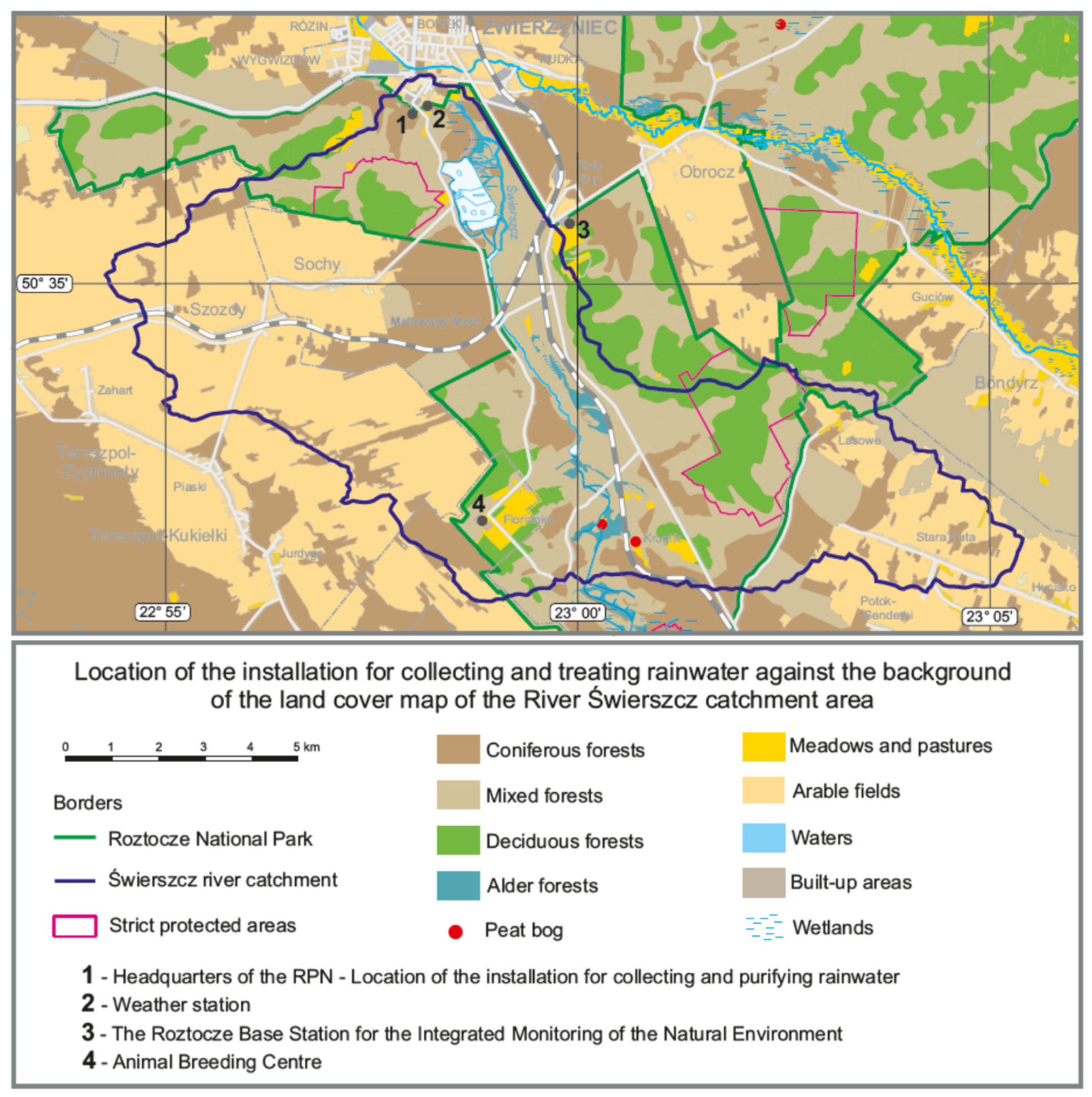
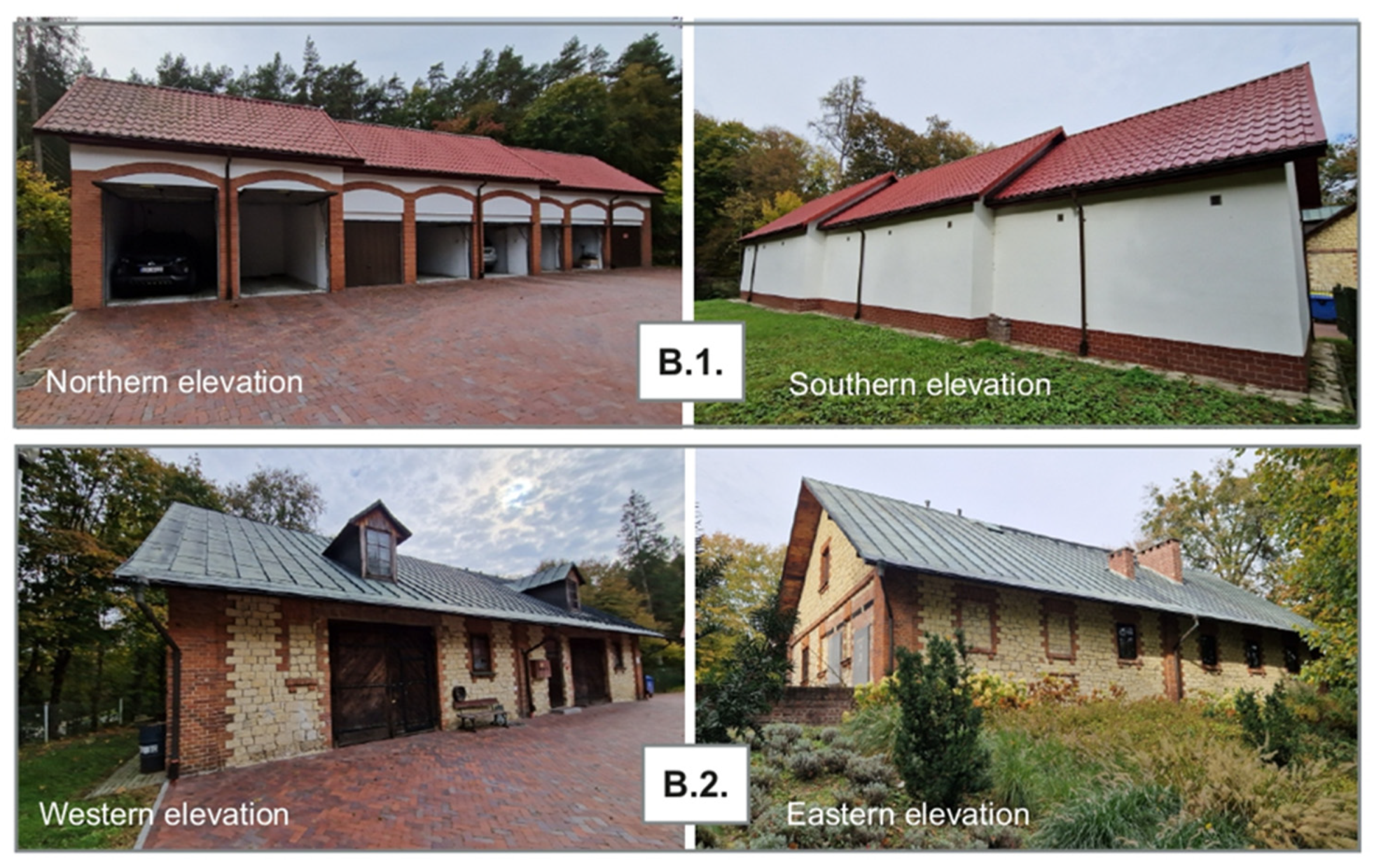
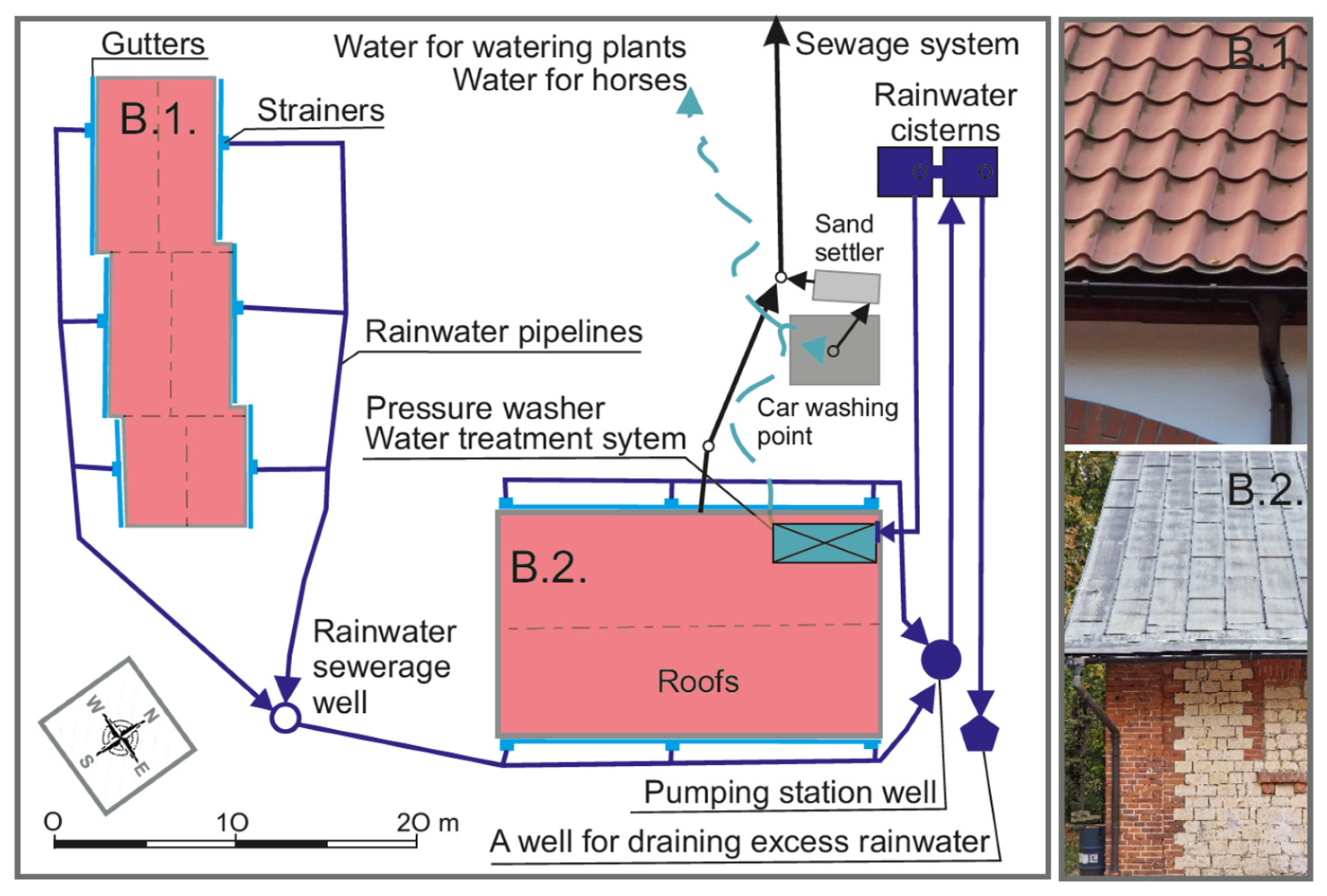



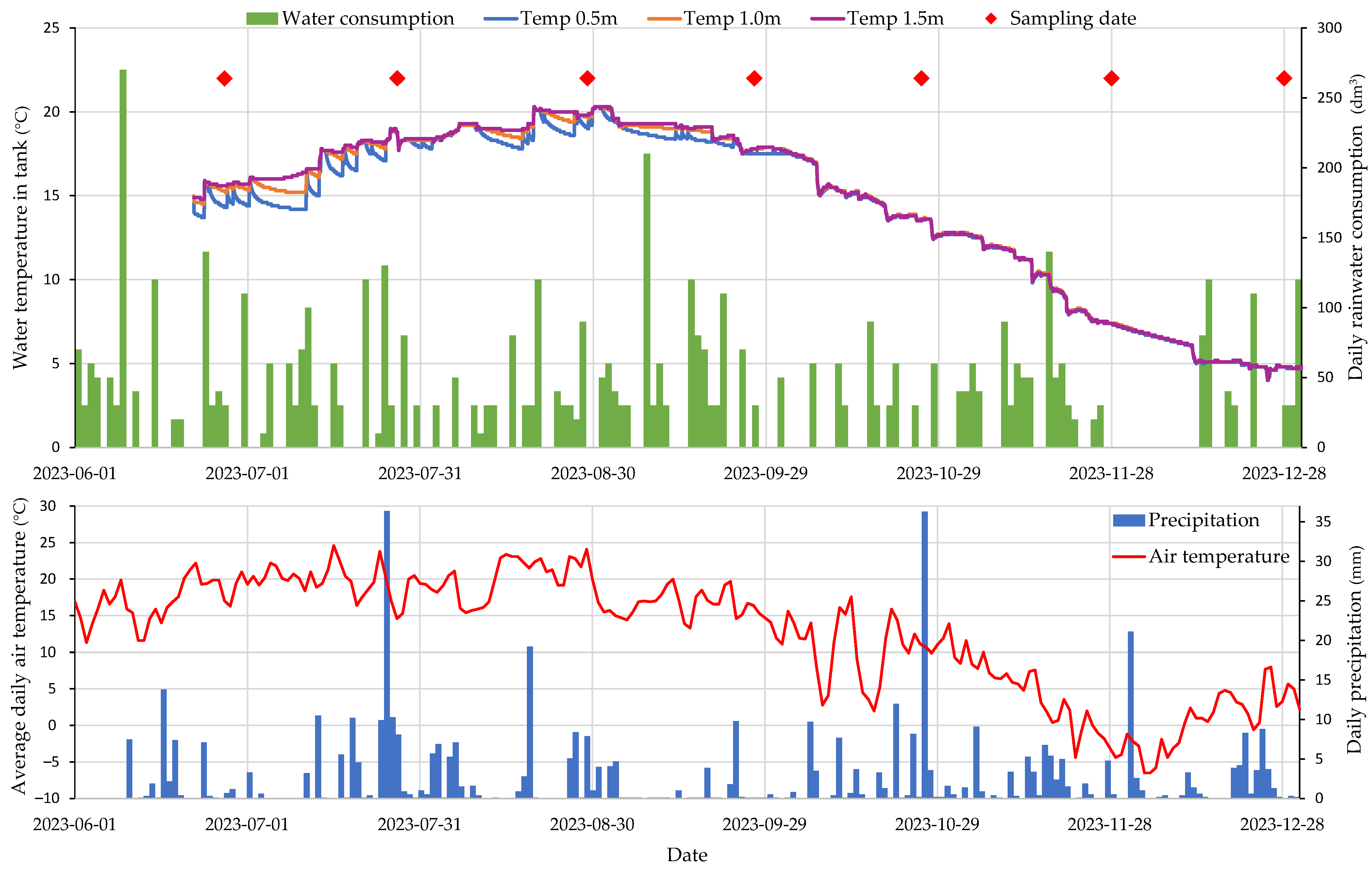
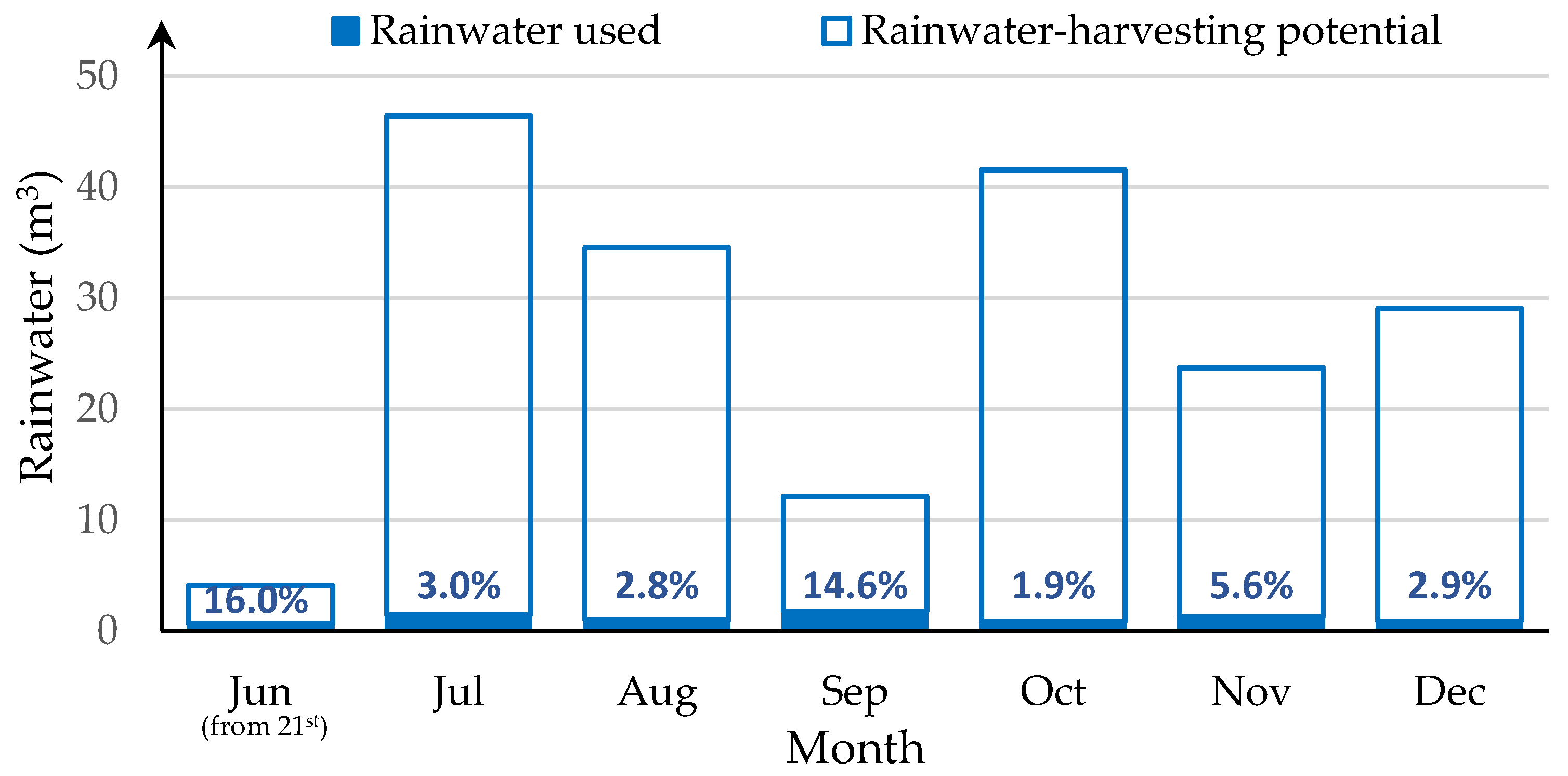
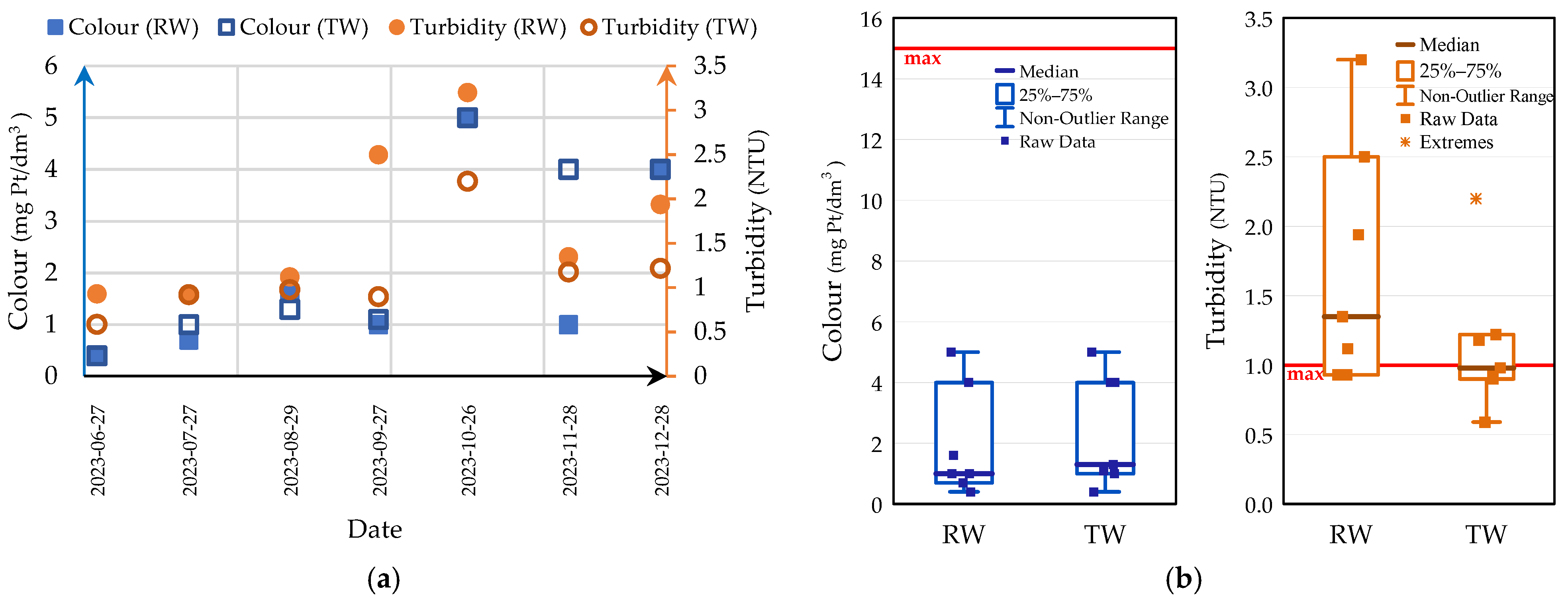
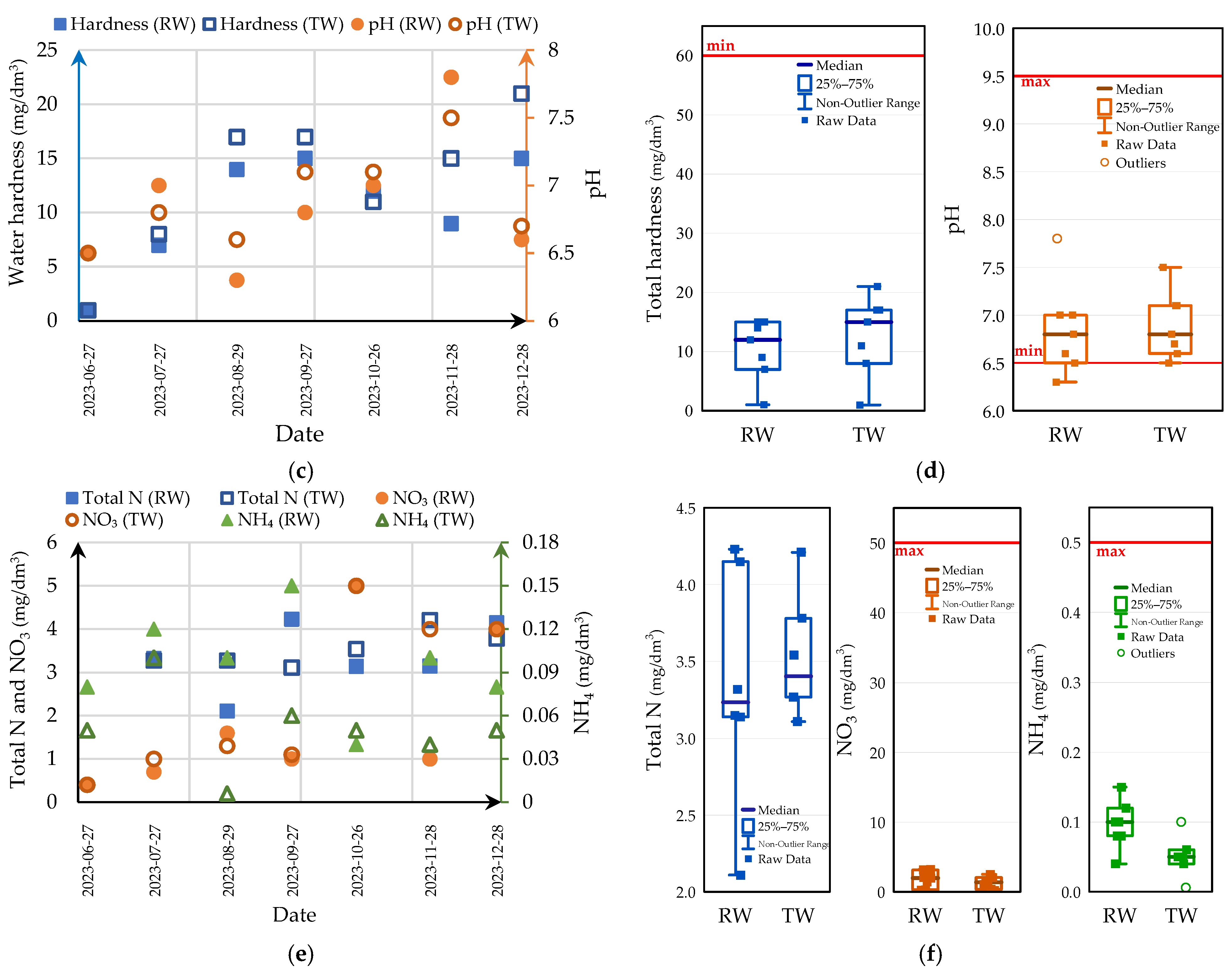
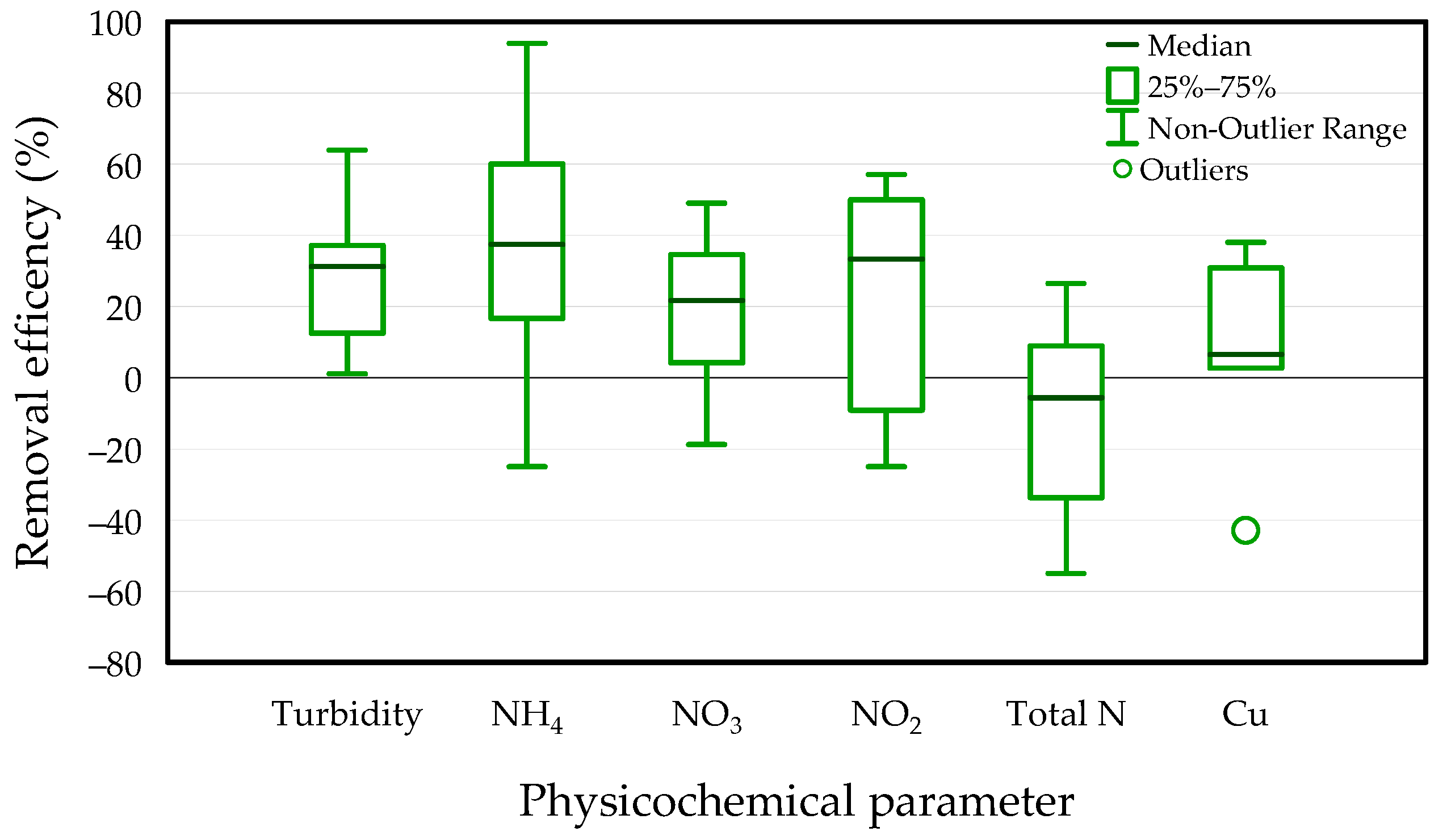

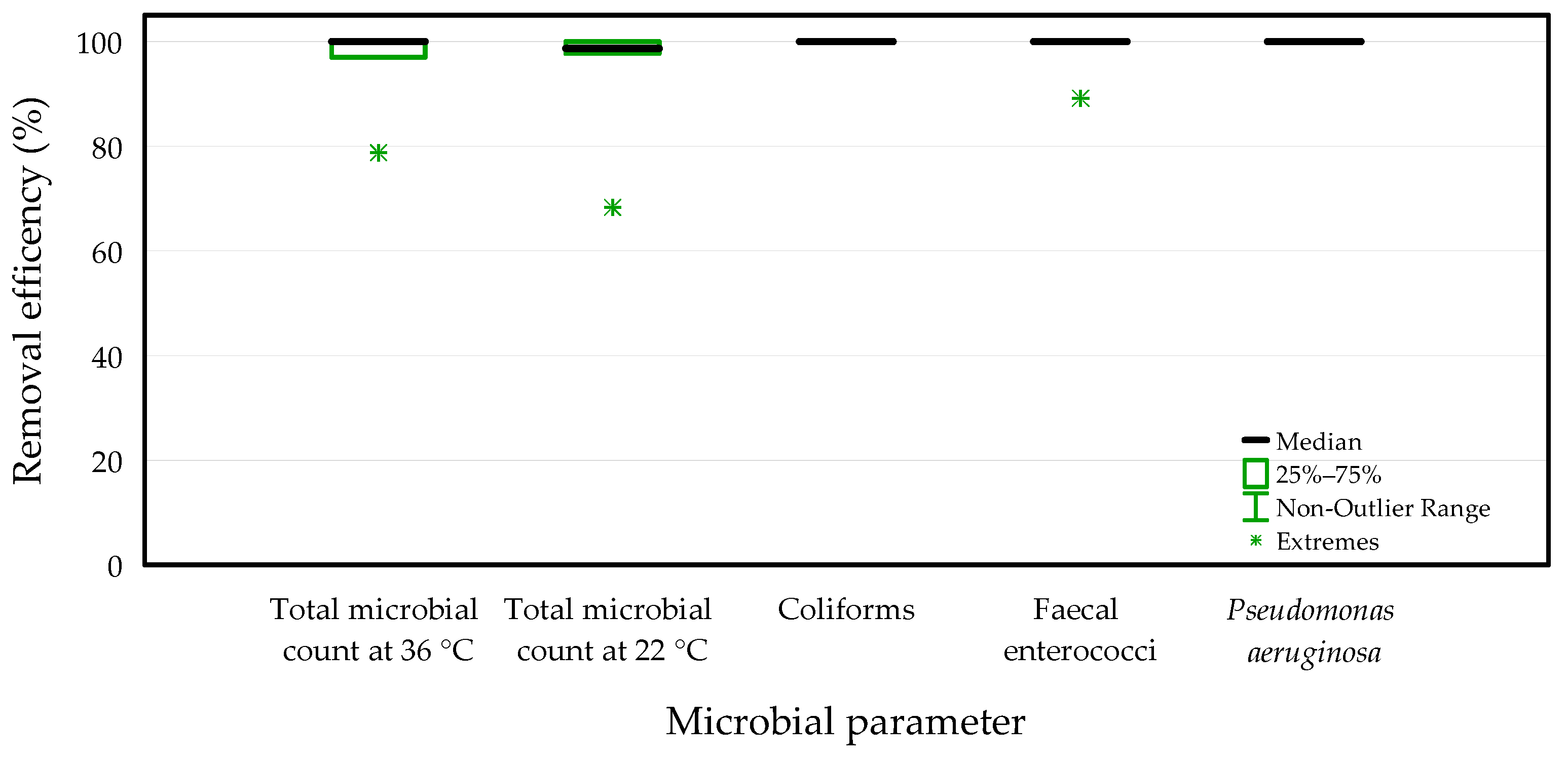
| Test Type | Parameter | Polish Standards Number |
|---|---|---|
| Microbiological tests | Total microbial count at 36 °C | PN-EN ISO 6222:2004 [36] |
| Total microbial count at 22 °C | ||
| Coliforms | PN-EN ISO 9308-1:2014-12+A1:2017-04 [37] | |
| Escherichia coli | ||
| Faecal enterococci | PN-EN 7899-2: 2004 standard [38] | |
| Pseudomonas aeruginosa | PN-EN ISO 16266:2009 [39] | |
| Organoleptic tests | Presence of a foreign odour | PN-EN 1622:2006 [40] |
| Threshold Odour Number (TON) | ||
| Physicochemical tests | Turbidity | PN-EN ISO 7027-1:2016-07 [41] |
| Colour | PN-EN ISO 7887:2012 [42] | |
| pH | PN-EN ISO 10523:2012 [43] | |
| Specific conductance at 25 °C | PN-EN 27888-1999 [44] | |
| Ammonium ions | PN-ISO 7150-1:2002 [45] | |
| Nitrates | PN-82/C-045576.08 [46] | |
| Nitrites | PN-EN 26777:1999 [47] | |
| Chlorides | PN-ISO 9297:1994 [48] | |
| Total hardness | PN-ISO 6059:1999 [49] | |
| Total nitrogen | PB/POŚ/06, 01.07.2011 [50] | |
| Total phosphorus | PN-EN ISO 6878:2006-7+Ap1:2010+Ap2:2010 [51] | |
| Silver | PN-EN ISO 17294-2:2016-11 [52] | |
| Copper | ||
| Sodium | ||
| Magnesium | ||
| Boron | ||
| Barium | ||
| Cobalt | ||
| Molybdenum | ||
| Zinc | ||
| Arsenic | ||
| Selenium | ||
| Antimony | ||
| Total Chrome | ||
| Total iron | ||
| Aluminium | ||
| Cadmium | ||
| Manganese | ||
| Nickel | ||
| Lead | ||
| Mercury |
| Month | I | II | III | IV | V | VI | VII | VIII | IX | X | XI | XII |
|---|---|---|---|---|---|---|---|---|---|---|---|---|
| Average air temperature [°C] | −1.4 | 5.4 | 4.5 | 7.7 | 12.7 | 17.0 | 19.8 | 20.1 | 16.4 | 10.8 | 3.6 | 0.8 |
| Precipitation [mm] | 90.2 | 62.5 | 63.1 | 58.1 | 58.4 | 43.1 | 105.9 | 78.8 | 27.7 | 94.8 | 54.1 | 65.3 |
| Parameter Unit | Sample | Min | Median | Mean | Max | SD | Wilcoxon z p-Value |
|---|---|---|---|---|---|---|---|
| Turbidity | RW | 0.93 | 1.35 | 1.71 | 3.2 | 0.88 | z = 2.37 |
| NTU | TW | 0.59 | 0.98 | 1.14 | 2.2 | 0.51 | p = 0.018 * |
| Colour | RW | 0.4 | 1 | 1.96 | 5.0 | 1.80 | z = 0.913 |
| mg Pt/dm3 | TW | 0.4 | 1.3 | 2.4 | 5.0 | 1.86 | p = 0.361 |
| pH | RW | 6.3 | 6.8 | - | 7.8 | - | z = 0.524 |
| - | TW | 6.5 | 6.8 | - | 7.5 | - | p = 0.600 |
| Specific conductance at 25 °C | RW | 8.8 | 29.1 | 25.87 | 34 | 9.17 | z = 2.206 |
| µS/cm | TW | 14 | 32.9 | 31.56 | 51 | 12.06 | p = 0.028 * |
| Ammonium ions | RW | 0.04 | 0.1 | 0.096 | 0.15 | 0.035 | z = 2.18 |
| mg/dm3 | TW | 0.006 | 0.05 | 0.051 | 0.1 | 0.028 | p = 0.028 * |
| Nitrates | RW | 0.24 | 1.98 | 1.78 | 3.23 | 1.21 | z = 2.031 |
| mg/dm3 | TW | 0.21 | 1.38 | 1.31 | 2.53 | 0.841 | p = 0.043 * |
| Nitrites | RW | 0.007 | 0.011 | 0.011 | 0.023 | 0.0054 | z = 1.77 |
| mg/dm3 | TW | 0.003 | 0.01 | 0.0088 | 0.015 | 0.0043 | p = 0.076 |
| Manganese | RW | 0.001 | 0.003 | 0.0031 | 0.008 | 0.0023 | z = 1.48 |
| mg/dm3 | TW | 0.001 | 0.005 | 0.0049 | 0.008 | 0.0030 | p = 0.138 |
| Total iron | RW | 0.0023 | 0.023 | 0.0232 | 0.046 | 0.0159 | z = 0.943 |
| mg/dm3 | TW | 0.0014 | 0.018 | 0.0165 | 0.031 | 0.0103 | p = 0.345 |
| Chlorides | RW | 0.98 | 1.21 | 2.199 | 4 | 1.416 | z = 1.05 |
| mg/dm3 | TW | 0.82 | 2 | 1.977 | 3 | 1.029 | p = 0.295 |
| Total hardness | RW | 1.02 | 12 | 10.43 | 15 | 5.15 | z = 1.77 |
| mg/dm3 | TW | 0.98 | 15 | 12.85 | 21 | 6.75 | p = 0.076 |
| Total nitrogen | RW | 2.11 | 3.235 | 3.35 | 4.23 | 0.78 | z = 0.524 |
| mg/dm3 | TW | 3.11 | 3.405 | 3.53 | 4.21 | 0.409 | p = 0.600 |
| Total phosphorus | RW | 0.005 | 0.0245 | 0.0262 | 0.05 | 0.018 | z = 0.734 |
| mg/dm3 | TW | 0.003 | 0.0315 | 0.0257 | 0.041 | 0.0149 | p = 0.463 |
| Copper | RW | 0.112 | 0.373 | 0.365 | 0.7 | 0.209 | z = 0.943 |
| mg/dm3 | TW | 0.109 | 0.2795 | 0.359 | 1 | 0.322 | p = 0.345 |
| Zinc | RW | 0.016 | 0.0585 | 0.054 | 0.079 | 0.021 | z = 2.20 |
| mg/dm3 | TW | 0.022 | 0.068 | 0.064 | 0.085 | 0.022 | p = 0.028 * |
| Parameter Unit | Sample | Min | Median | Mean | Max | SD | Wilcoxon z p-Value |
|---|---|---|---|---|---|---|---|
| Total microbial count at 22 °C | RW | 78 | 160 | 3045.4 | 14,000 | 5091.6 | z = 2.37 |
| cfu/cm3 | TW | 0 | 0 | 73.71 | 420 | 154.6 | p = 0.018 * |
| Total microbial count at 36 °C | RW | 120 | 610 | 4314.3 | 23,000 | 8342.0 | z = 2.37 |
| cfu/cm3 | TW | 0 | 25 | 91.57 | 520 | 190.2 | p = 0.018 * |
| Coliforms | RW | 0 | 0 | 1.429 | 10 | 3.780 | - |
| cfu/100 cm3 | TW | 0 | 0 | 0 | 0 | - | |
| Escherichia coli | RW | 0 | 0 | 0 | 0 | - | - |
| cfu/100 cm3 | TW | 0 | 0 | 0 | 0 | - | |
| Faecal enterococci | RW | 1 | 15 | 19.57 | 48 | 17.99 | z = 2.37 |
| cfu/100 cm3 | TW | 0 | 0 | 0.571 | 4 | 1.511 | p = 0.018 * |
| Pseudomonas aeruginosa | RW | 0 | 0 | 14 | 38 | 17.66 | z = 1.60 |
| cfu/100 cm3 | TW | 0 | 0 | 0 | 0 | - | p = 0.109 |
Disclaimer/Publisher’s Note: The statements, opinions and data contained in all publications are solely those of the individual author(s) and contributor(s) and not of MDPI and/or the editor(s). MDPI and/or the editor(s) disclaim responsibility for any injury to people or property resulting from any ideas, methods, instructions or products referred to in the content. |
© 2024 by the authors. Licensee MDPI, Basel, Switzerland. This article is an open access article distributed under the terms and conditions of the Creative Commons Attribution (CC BY) license (https://creativecommons.org/licenses/by/4.0/).
Share and Cite
Grabowski, T.; Bochniak, A.; Siwiec, T.; Jóźwiakowski, K. Pollutant Removal Efficiency in a Rainwater Treatment System in Roztocze National Park (Poland). Sustainability 2024, 16, 4709. https://doi.org/10.3390/su16114709
Grabowski T, Bochniak A, Siwiec T, Jóźwiakowski K. Pollutant Removal Efficiency in a Rainwater Treatment System in Roztocze National Park (Poland). Sustainability. 2024; 16(11):4709. https://doi.org/10.3390/su16114709
Chicago/Turabian StyleGrabowski, Tadeusz, Andrzej Bochniak, Tadeusz Siwiec, and Krzysztof Jóźwiakowski. 2024. "Pollutant Removal Efficiency in a Rainwater Treatment System in Roztocze National Park (Poland)" Sustainability 16, no. 11: 4709. https://doi.org/10.3390/su16114709
APA StyleGrabowski, T., Bochniak, A., Siwiec, T., & Jóźwiakowski, K. (2024). Pollutant Removal Efficiency in a Rainwater Treatment System in Roztocze National Park (Poland). Sustainability, 16(11), 4709. https://doi.org/10.3390/su16114709










